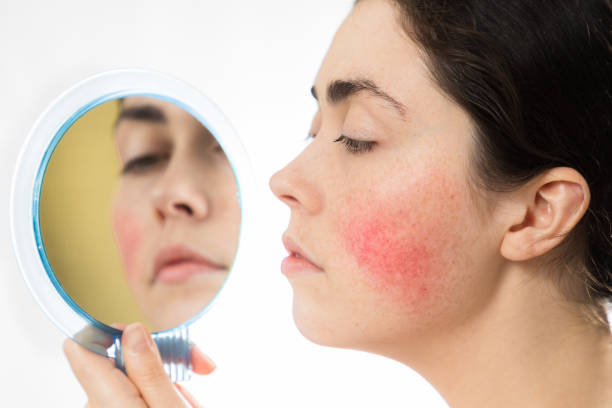
Rosacea is a common skin condition that affects many people.
It typically appears as redness or flushing on the face, although other signs and symptoms may develop as well.
In this article, we’ll demystify rosacea by discussing the various causes, symptoms, and treatment options available for those who suffer from it.
What is Rosacea?
Rosacea (See Amazon) is a chronic skin condition that primarily affects the face.
It’s characterized by its redness or flushing appearance, usually in the cheeks, nose, and chin.
It can be a mild or severe condition, and some people may experience other symptoms such as a burning or stinging sensation, small bumps or pimples, and broken blood vessels on the face.
In some cases, symptoms can worsen and flare-up.

Causes of Rosacea

The exact cause of rosacea isn’t well understood, but it’s believed to be the result of a combination of environmental and genetic factors. The following factors may contribute to the development of rosacea:
- Genetics (See Amazon)– People whose family members have rosacea have a higher chance of developing it themselves.
- Demodex mites (See Amazon)– These tiny parasites are commonly found on the skin and hair follicles of most people. However, in larger numbers, they may cause eye or skin problems, including rosacea. The exact link between demodex mites and rosacea is still largely unknown.
- Environmental triggers – A variety of environmental triggers may cause rosacea to flare up or worsen, including sun exposure, heat, spicy foods, alcohol, and stress.
- Abnormal blood vessels – In some cases, rosacea has been associated with an abnormality in blood vessels in the skin. In these cases, the blood vessels may dilate too much, causing the skin to appear red or flushed.
- Other factors – Certain factors, such as high-fat diets and excessive consumption of caffeine, may trigger or worsen symptoms in some people.
Rosacea Symptoms
The primary symptom of rosacea is redness that spreads across the face, usually in the cheeks, nose, and chin. Other symptoms and signs of rosacea may include:
- Small, red bumps or pimples (See Amazon) – These are often mistaken for acne.
- Burning or stinging sensations (See Amazon)- People with rosacea may experience a burning or stinging sensation in the skin of their face.
- Blood vessels that are visible (See Amazon)– Often, people with rosacea will have visible blood vessels on their face, especially around the nose and cheeks.
- Thickened, bumpy skin – In rare cases, the skin may thicken and develop bumps or plaques.
- Eye symptoms (See Amazon)– In some cases, people with rosacea may experience eye dryness, irritation, or sensitivity to light.

Sensible Skin Rosacea Symptoms
Treatment Options for Rosacea
Roberta Sengelmann, MD, a board-certified dermatologist and medical aesthetics expert, recommends the following steps for diagnosing and treating rosacea:
Diagnosing Rosacea
If you suspect that you have rosacea, you should make an appointment with a dermatologist for a proper diagnosis. During the visit, the dermatologist will discuss your symptoms and medical history, and may perform certain tests to rule out other conditions.
Treating Rosacea
According to Dr. Sengelmann, there are several treatments and strategies for managing and controlling symptoms. Depending on the type and severity of your rosacea, a dermatologist may recommend one or more of the following:
- Topical Medications (See Amazon)– Topical medications, such as gels, creams, and lotions, can help reduce redness and inflammation.
- Oral Medications – Oral medications, including antibiotics, antihistamines, and anti-inflammatories, may be prescribed to help relieve symptoms.
- Laser Therapy – In some cases, laser therapy may be used to reduce the appearance of redness and blood vessels on the face.
- Peels and Microdermabrasion – Chemical peels and microdermabrasion treatments can help improve the appearance of the skin and reduce redness and inflammation.
- Skin Care Products (See Amazon)– Your dermatologist may recommend specific skin care products that are appropriate for your skin type and can help relieve symptoms.

Takeaway
Rosacea is a common skin condition that primarily affects the face. It’s characterized by redness or flushing, with other symptoms such as burning, stinging, small bumps, and visible blood vessels sometimes present.
While the exact cause of rosacea isn’t well understood, it’s likely a combination of genetic and environmental factors. There are several treatment options and strategies available for managing and controlling symptoms of rosacea, including topical and oral medications, laser therapy, peels and microdermabrasion, and appropriate skin care products.
If you suspect that you have rosacea, it’s important to make an appointment with a dermatologist for a proper diagnosis and treatment plan.
It’s important for people with rosacea to remember that the condition is not dangerous or life-threatening. However, it can be very frustrating and may negatively impact a person’s self-esteem and confidence. The good news is that there are a variety of treatment options available to help control and manage symptoms.
